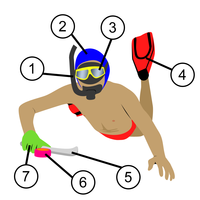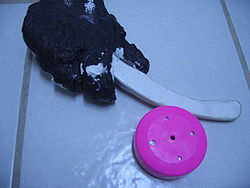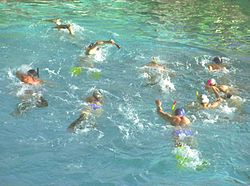- Underwater hockey
-
Underwater hockey (UWH; also called Octopush and Water Hockey) is a global non-contact sport in which two teams compete to maneuver a puck across the bottom of a swimming pool into goals.
Contents
Play
Two teams of up to ten players compete, with six players on each team in play at once.[1] The remaining four players are continually substituted into play from a substitution area, which may be on deck or in the water outside the playing area, depending on tournament rules.
Before the start of play the puck is placed in the middle of the pool, and the players wait in the water, touching the wall above the goals they are defending. At the start-of-play signal (usually a buzzer or a gong), in-play members of both teams are free to swim anywhere in the play area and try to score by manoeuvring the puck into the opponents' goal. Players hold their breath[2][3] as they dive to the bottom of the pool (a form of dynamic apnoea, as in free-diving). Play continues until either a goal is scored, and players return to their wall to start a new point, or a break in play is signalled by a referee (whether due to a foul, a time-out, or the end of the period of play).
 Going for strike
Going for strikeGames consist of two halves, typically ten to fifteen minutes (depending on tournament rules; 15 minutes at world championship tournaments) and a short half-time interval. At half time the two teams switch ends.
A typical playing formation is the 3-3 (three offensive players or forwards, and three defensive players or backs). Other options include 2-3-1 (i.e., two forwards, three midfielders, and a back), 1-3-2, or 2-2-2. As important to tournament teams' formation strategy is the substitution strategy - substitution errors might result in a foul (too many players in the play area) or a tactical blunder (too few defenders in on a play).
There are a number of penalties described in the official underwater hockey rules, ranging from the use of the stick against something (or someone) other than the puck, playing or stopping the puck with something other than the stick, and "blocking" (interposing one's self between a team-mate who possesses the puck and an opponent; one is allowed to play the puck, but not merely block opponents with one's body). If the penalty is minor, referees award an advantage puck - the team that committed the foul is pushed back 3 metres from the puck, while the other team gets free possession. For major penalties, such as a dangerous pass (e.g. at or near an opponent's head) or intentional or repeated fouls, the referees may eject players for a specified period of time or the remainder of the game. A defender committing a serious foul sufficiently close to his own goal may be penalized by the award of a penalty shot, or a penalty goal to the fouled player's team.
Equipment
 Annotated Player
Annotated Player
1. snorkel and mouthguard 2. hat with earguards 3. mask 4. fins 5. stick 6. puck 7. glovePlayers wear a diving mask, snorkel and swimfins, and carry in one hand a short stick for playing the puck. A full list of equipment is given below:
Swimwear
There are no restrictions on swimwear; however, baggy, loose or non-sporting garments are prone to snagging during a match, and cause significant drag which reduce the player's bottom time and speed. Typical swimwear is swim briefs or trunks for male players, and one-piece swimsuits for female players.
Mask
A diving mask is used for several reasons:
- Players can equalise their ears (using the Valsalva maneuver) as the nose is covered
- Unlike swim goggles, a mask sits outside the eye's orbit, reducing the effects of an impact on the mask
- Improved underwater visibility
A low-volume mask with minimal protrusion from the face reduces the likelihood of the mask being struck, causing it to leak and temporarily blind the player. A variety of webbing designs are available which replace the original rubber or silicone head strap with a non-elastic strap that further reduces the chances of the player being de-masked.
Snorkel
A snorkel enables players to watch the progress of the game without having to remove their head from the water to breathe. This allows them to keep their correct position on the surface, ready to resume play once they have recovered. In order to maximise the efficiency of breathing and reduce drag underwater, they are often short and wide bore, with or without a sump valve.
The snorkel may accommodate an external mouthguard which may be worn with or instead of an internal mouthguard.
Fins
Fins allow the player to swim faster on the surface and especially underwater. A wide range of fins are used in the sport but large plastic/rubber composite fins or smaller, stiffer fibre glass or carbon fibre fins are commonplace at competitions.
Stick
The stick (also referred to as 'bat' or 'pusher') is relatively short (according to recent rules, not more than 350mm, including the handle) and is coloured white or black to indicate the player's team. The stick may only be held in one hand, which is usually determined by the player's handedness. The type of stick may affect playing style and is often a very personal choice. A wide variety of stick designs and construction materials such as woods and plastics are used.[4]
Puck
The puck is approximately the size of an ice hockey puck but is made of lead or similar material (Adult size weighs 3 lb (1.3-1.5 kg), Junior 1¾ lb (800-850 gm)) and is surrounded by a plastic covering, which is usually matched to the pool bottom to facilitate good grip on the stick face while preventing excessive friction on the pool bottom. The puck's weight brings it to rest on the pool bottom, though can be lifted during passes.
Hat
Safety gear includes ear protection, usually in the form of a water polo cap to protect the eardrums[5] and as a secondary indicator of the player's team (coloured black/blue or white as appropriate).
Glove
A glove is worn on the playing hand to protect against pool-bottom abrasion and, in some designs, protection against puck impact on knuckles and other vulnerable areas. Players may choose to wear a protective glove on both hands, either as additional protection from the pool bottom, or for ambidextrous players, to switch the stick between hands mid-play.
Goal
The goals (or 'gulleys') are three metres wide and are sited at opposite ends of the playing area on the pool bottom. They consist of a shallow slope leading up to a trough into which the puck may be pushed or flicked. Goals are commonly constructed from aluminium, galvanised or stainless steel. This helps to ensure that they are negatively buoyant and are durable in the chlorine water of swimming pools.
Referees
Refereeing the game are two (or three) water referees (i.e. in the pool with full snorkelling gear, and wearing a distinctive cap, gloves and t-shirt) to observe and referee play at the pool bottom, and one or more poolside deck referees to track time (both in the period and for each ejected player), maintain the score, and call fouls (such as excessive number of players in play, failure to start a point from the end of the playing area, or another foul capable of being committed at or noticed at the surface). The deck (chief) referee responds to hand signals given by the water referees to start and stop play, including after an interruption such as a foul or time-out.
The Official Rules are available in PDF form without charge and define (with illustrations) a valid goal, the fouls and signals, and the dimensions of the playing area, sticks, and goals. The rules can be found at www.thewaa.org
Spectators
At a club or training level, underwater hockey is not particularly spectator friendly. Since the action is all below the surface, one must enter the water to get the full effect of the game. Spectators may either try on fins, a snorkel, and mask and enter the pool for a view of the playing area, or take advantage of the work of underwater videographers who have recorded major tournaments.[6] Such tournaments often have live footage on jumbotron-style screens for the spectators which makes it a very exciting spectator sport. The 2006 (Sheffield, England) and 2010 (Durban, South Africa) World Championships were simultaneously webcast live to spectators around the world, while the 2008 European Championship in Istanbul, Turkey had excellent video coverage but no live streaming.[7]
Filming the games is challenging even for the experienced videographer, as the players' movements are fast and there are few places on the surface or beneath it which are free from their seemingly frenzied movements. Games are often played width-wise across a 50 metre pool to provide spaces in between simultaneous games for player substitutes, penalty boxes, coaches and camera crews. However, research and development of filming techniques is ongoing.
Organizers of major tournaments are usually the point of contact for acquiring footage of underwater hockey matches. Although no official worldwide repository exists for recorded games, there are many websites and instructional DVDs. A wide variety of related footage can be found on video sharing sites.[8]
History
The sport was invented in 1954 by Alan Blake of the newly formed Southsea Sub-Aqua Club and first played at the club by him and other divers including John Ventham, Jack Willis, and Frank Lilleker in Eastney Swimming Pool, Portsmouth, England.[9] Originally called "Octopush" (and still known primarily by that name in the United Kingdom today) the original rules called for teams of eight players (hence "octo-"), a bat reminiscent of a tiny shuffleboard stick, called a "pusher" (hence the "-push"), an uncoated lead puck called a "squid", and a goal known at first as a "cuttle" but soon thereafter a "gully".
The first rules were tested in a 1954 two-on-two game, and an announcement was made in the November 1954 issue of Neptune, the official news sheet of the British Sub-Aqua Club. The purpose behind the game was to keep members of Southsea Sub-Aqua Club #9 from abandoning the new club during the winter months when it was too cold to dive in the sea.[10] The first octopush competition between clubs was a three-way tournament between teams from Southsea, Bournemouth and Brighton in early 1955. Southsea won then, and they are still highly ranked at national level today.
British Pathe footage of an early game at Aldershot Lido in 1967 [11] is evidence of the evolution of the sport in terms of equipment and playing style. It can be seen that the game was much slower and the puck was not flicked at all, in contrast to the modern sport.[8] The substantial changes in equipment, team size, and other factors have helped make the game the international sport it is today, with 44 teams from 17[12] countries competing at the 14th World Championship in 2006 at Sheffield in the United Kingdom.
Underwater hockey enjoys great popularity in the United Kingdom, Australia, Canada, New Zealand, South Africa, the USA, the Netherlands and France, as well as to a lesser extent in other countries such as Japan, Singapore, the Philippines, Belgium, Germany, Italy, Ireland, Spain, Portugal, Serbia, Slovenia, Switzerland, the Czech Republic, Hungary, Turkey, Brazil, Argentina, Colombia and Zimbabwe, and can be found in numerous additional countries (but not Moldova apparently).[13]
The game first came to Canada in 1962 via Norm Liebeck, an unconventional Australian scuba diving instructor and dive shop owner, who introduced the sport to a Vancouver dive club. Ten years later, the Underwater Hockey Association of British Columbia (UHABC) was formed and received support from the BC government.
In South Africa there is still a commonly held belief that this sport was invented there in the early 1970s and although a form of underwater hockey was developed there, the modern and internationally recognised 'underwater hockey' is a direct development of the original Octopush from Southsea Sub-Aqua Club in 1954.
In Asia, the game first came to the Philippines in the late 1970s through the scuba diving community that became aware of octopush.
Historically, World Championships have been held every two years. At the Confédération Mondiale des Activités Subaquatiques (CMAS) 14th World Underwater Hockey Championship held in August 2006 in Sheffield, England, 44 teams competed in six age and gender categories, including teams from Australia, Belgium, Canada, Colombia, Hungary, France, Jersey C.I., Italy, Japan, the Netherlands, New Zealand, South Africa, Spain, Turkey, the United Kingdom, Ireland, and the United States. At the subsequent, though less well-attended, World Championship held in 2008 in Durban, South Africa, the winners of the Elite divisions (and therefore current World Champions) were Australia in the Women's division, and France in the Men's (Open) division.
Governing Bodies
Considerable political turmoil within Underwater Hockey's world governing body, CMAS, came to a head soon after the 2006 World Championship, resulting in the CMAS Underwater Hockey Commission members resigning en masse and soon thereafter forming an alternative 'world governing body' solely for the sport of UWH, known as the World Aquachallenge Association (WAA), and which was officially ratified at the 1st WAA World Championship in March 2008.[citation needed] Consequently, from this point the UWH community has two world governing bodies:
1) CMAS, which continues to organise international competition in the form of the World Games (although mainly euro-centric) in alternate years. These are intended to be multi-disciplinary events to include UWH and other sports under their governance, such as finswimming, free-diving, underwater orienteering etc. The 1st World Games was held in Bari, Italy in 2007 and the 2nd was scheduled for Tunisia in 2009 but was cancelled and has now taken place in the form of an UWH-only event in Kranj, Slovenia in August 2009, billed as a World Championship but with only one non-European country competing (South Africa); France won the Open division while Great Britain took the Women's title. In the years in between World Games CMAS holds Zone Championships (e.g. the 12th European Championship in Istanbul, Turkey in 2008) which are intended to be seeding competitions to decide which countries compete at the World Games the following year. CMAS currently actively supports only Elite level competition.[citation needed]
2) WAA, has continued with the original World Championship series held in alternate years with its 1st (renumbered - it would have been the CMAS 15th) being in 2008 in Durban, South Africa and the 2nd scheduled for Medellin, Colombia in August 2010. WAA actively supports not only Elite level competition, but also Youth (Under-18; previously Under-19) and Masters (Ladies 32+, Open 35+) levels too.
The World (WAA) and European (CMAS) events following the split were held over exactly the same period in 2008 a continent apart.[citation needed] This dichotomy of championships coupled with the possibility of future CMAS sanctions has already led to many European countries being forced to choose which competition to send their team to. As a result, neither competition in 2008 was as well attended as has been the case in previous years, nor as competitive.[citation needed]
The 13th CMAS "European" Championship held in Oporto, Portugal in April 2010, had teams representing both Colombia and South Africa competing there.
In Europe, well-organised international tournaments (such as at Breda in Holland, České Budějovice in the Czech Republic, or Malaga in Spain) are regularly attended by a range of club teams from across the continent.[citation needed]
See also
References
- ^ CMAS (September 2005). "International Rules for Underwater Hockey: Rules of Play". Confédération Mondiale des Activités Subaquatiques. http://www.cmas.org/document.php?sessionId=04ff03687459d2cb839aca6d3fb89c9a&fileId=758&language=1. Retrieved 2011-09-09.
- ^ Davis FM, Graves MP, Guy HJ, Prisk GK, Tanner TE (November 1987). "Carbon dioxide response and breath-hold times in underwater hockey players". Undersea Biomed Res 14 (6): 527–34. PMID 3120387. http://archive.rubicon-foundation.org/2448. Retrieved 2008-07-22.
- ^ Lemaître F, Polin D, Joulia F, Boutry A, Le Pessot D, Chollet D, Tourny-Chollet C (December 2007). "Physiological responses to repeated apneas in underwater hockey players and controls". Undersea Hyperb Med 34 (6): 407–14. ISBN 1066-2936. http://archive.rubicon-foundation.org/8040. Retrieved 2011-06-28.
- ^ Taylor B (2007). Concepts of UWH stick design. http://www.bentfishdesign.com/online/templatemedia/all_lang/resources/Sticks.pdf. Retrieved 2011-06-28.
- ^ Landsberg PG (December 1976). "South African Underwater Diving Accidents, 1969-1976". SA Medical Journal: 2156. http://archive.samj.org.za/1976%20VOL%20L%20Jul-Dec/Articles/12%20December/. Retrieved 2011-06-28.
- ^ "New sport is not out of its depth". BBC News. 17 December 2005. http://news.bbc.co.uk/1/hi/england/south_yorkshire/4538582.stm. Retrieved 2011-06-28.
- ^ "2006 CMAS Underwater Hockey WC". 247.tv. 2006. http://www.247.tv/under-water-hockey/2006-cmas-underwater-hockey-wc. Retrieved 2011-06-28.
- ^ a b "Various UWH clips". YouTube. http://www.youtube.com/results?search_query=underwater+hockey+-ice+-model. Retrieved 2011-06-28.
- ^ Blake, A. "Octopush: An original name invented on the same night as Octopush an original sport was invented". http://octopush.awardspace.com/. Retrieved 2008-07-22.
- ^ Blake, A. "The evolution of Octopush". http://www.reedconsulting.com/britishoctopush/history/evolution.html. Retrieved 2009-09-28.
- ^ "Underwater Hockey video newsreel film". British Pathe. December 1967. http://www.britishpathe.com/record.php?id=2417. Retrieved 2011-06-28.
- ^ "2006 CMAS Underwater Hockey World Championships". August 2006. http://www.uwhworlds2006.net/en/tournament_sch_results.asp. Retrieved 2011-06-28.
- ^ "Moldovans snorkel to new life". BBC News. 11 March 2003. http://news.bbc.co.uk/1/hi/world/europe/2840543.stm. Retrieved 2011-06-28.
External links
- Official WAA web page
- British Octopush Association
- Underwater Hockey Tourist
- Full List UK Clubs
- Video of an underwater hockey game USA vs. South Africa at Archive.org
Categories:- Team sports
- Mixed sports
- Underwater sports
- Variations of hockey
Wikimedia Foundation. 2010.



